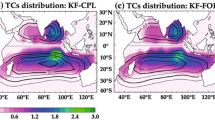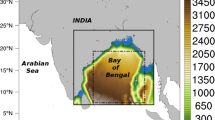Abstract
In this study, the interaction between the tropical cyclone (TC) and the underlying ocean is reproduced by using a coupled atmosphere-ocean model. Based on the simulation results, characteristics of the TC boundary layer depth are investigated in terms of three commonly used definitions, i.e., the height of the mixed layer depth (HVTH), the height of the maximum tangential winds (HTAN), and the inflow layer depth (HRAD). The symmetric height of the boundary layer is shown to be cut down by the ocean response, with the decrease of HVTH slightly smaller than that of HTAN and HRAD. The ocean feedback also leads to evident changes in asymmetric features of the boundary layer depth. The HVTH in the right rear of the TC is significantly diminished due to presence of the cold wake, while the changes of HVTH in other regions are rather small. The decreased surface virtual potential temperature by the cold wake is identified to be dominant in the asymmetric changes in HVTH. The impacts of ocean response on the asymmetric distributions of HTAN are nonetheless not distinct, which is attributed to the highly axisymmetric property of tangential winds. The HRAD possesses remarkable asymmetric features and the inflow layer does not exist in all regions, an indication of the inadequacy of the definition based on symmetric inflow layer depth. Under influences of the cold wake, the peak inflow area rotates counterclockwise distinctly. As a consequence, the HRAD becomes deeper in the east while shallower in the west of the TC.
Similar content being viewed by others
References
Anthes, R. A., and S. W. Chang, 1978: Response of the hurricane boundary layer to changes of sea surface temperature in a numerical model. J. Atmos. Sci., 35, 1240–1255.
Bender, M. A., and I. Ginis, 2000: Real-case simulations of hurricane-ocean interaction using a high-resolution coupled model: Effects on hurricane intensity. Mon. Wea. Rev., 128, 917–946.
Betts, A. K., and M. J. Miller, 1986: A new convective adjustment scheme. Part II: Single column tests using GATE wave, BOMEX, ATEX and arctic airmass data sets. Quart. J. Roy. Meteor. Soc., 112, 693–709.
Bryan, G. H., and R. Rotunno, 2009: The maximum intensity of tropical cyclones in axisymmetric numerical model simulations. Mon. Wea. Rev., 137, 1770–1789.
Chen, S., T. J. Campbell, H. Jin, et al., 2010: Effect of two-way air-sea coupling in high and low wind speed regimes. Mon. Wea. Rev., 138, 3579–3602.
Duan, Y. H., R. S. Wu, R. L. Yu, et al., 2013: Numerical simulation of tropical cyclone intensity change with a coupled air-sea model. Acta Meteor. Sinica, 27, doi: 10.1007/s13351-013-0503-2. (in press)
Emanuel, K. A., 1986: An air-sea interaction theory for tropical cyclones. Part I: Steady-state maintenance. J. Atmos. Sci., 43, 585–605.
—, 1988: The maximum intensity of hurricanes. J. Atmos. Sci., 45, 1143–1155.
—, 1995: Sensitivity of tropical cyclones to surface exchange coefficients and a revised steady-state model incorporating eye dynamics. J. Atmos. Sci., 52, 3969–3976.
Hogsett, W., and D.-L. Zhang, 2009: Numerical simulation of Hurricane Bonnie (1998). Part III: Energetics. J. Atmos. Sci., 66, 2678–2696.
Holton, J. R., 2004: An Introduction to Dynamic Meteorology. 4th ed, Elsevier Academic Press, Burlington, 529 pp.
Hong, S. Y., Y. Noh, and J. Dudhia, 2006: A new vertical diffusion package with an explicit treatment of entrainment processes. Mon. Wea. Rev., 134, 2318–2341.
Jordan, C. L., 1958: Mean soundings for the west indies area. J. Meteor., 15, 91–97.
Kepert, J. D., 2001: The dynamics of boundary layer jets within the tropical cyclone core. Part I: Linear theory. J. Atmos. Sci., 58, 2469–2484.
—, 2006a: Observed boundary layer wind structure and balance in the hurricane core. Part I: Hurricane Georges. J. Atmos. Sci., 63, 2169–2193.
—, 2006b: Observed boundary layer wind structure and balance in the hurricane core. Part II: Hurricane Mitch. J. Atmos. Sci., 63, 2194–2211.
—, 2010a: Slab- and height-resolving models of the tropical cyclone boundary layer. Part I: Comparing the simulations. Quart. J. Roy. Meteor. Soc., 136, 1686–1699, doi: 10.002/qj.667.
—, 2010b: Slab- and height-resolving models of the tropical cyclone boundary layer. Part II: Why the simulations differ. Quart. J. Roy. Meteor. Soc., 136, 1700–1711, doi: 10.002/qj.685.
—, and Y. Q. Wang, 2001: The dynamics of boundary layer jets within the tropical cyclone core. Part II: Nonlinear enhancement. J. Atmos. Sci., 58, 2485–2501.
Liu, B., H. Q. Liu, L. Xie, et al., 2011a: A coupled atmosphere-wave-ocean modeling system: Simulation of the intensity of an idealized tropical cyclone. Mon. Wea. Rev., 139, 132–152.
Liu Lei, Fei Jianfang, Lin Xiaopei, et al., 2011b: Study of the air-sea interaction during Typhoon Kaemi (2006). Acta Meteor. Sinica, 25, 625–638.
Ma, Z. H., J. F. Fei, L. Liu, et al., 2013a: Effects of the cold core eddy on tropical cyclone intensity and structure under idealized air-sea interaction conditions. Mon. Wea. Rev., 141, 1285–1303.
—, —, X. G. Huang, et al., 2013b: The effects of ocean feedback on tropical cyclone energetics under idealized air-sea interaction conditions. J. Geophys. Res., doi: 10.1002/jgrd.50780. (in press)
Mellor, G. L., 2004: Users guide for a three-dimensional, primitive equation, numerical ocean model (June 2004 version). Prog. in Atmos. and Ocean. Sci., Princeton University, 56 pp.
Nolan, D. S., J. A. Zhang, and D. P. Stern, 2009a: Evaluation of planetary boundary layer parameterizations in tropical cyclones by comparison of in-situ observations and high-resolution simulations of Hurricane Isabel (2003). Part I: Initialization, maximum winds, and the outer-core boundary layer. Mon. Wea. Rev., 137, 3651–3674.
—, D. P. Stern, and J. A. Zhang, 2009b: Evaluation of planetary boundary layer parameterizations in tropical cyclones by comparison of in situ observations and high-resolution simulations of Hurricane Isabel (2003). Part II: Inner-core boundary layer and eyewall structure. Mon. Wea. Rev., 137, 3675–3698.
Schade, L. R., and K. A. Emanuel, 1999: The ocean’s effect on the intensity of tropical cyclones: Results from a simple coupled atmosphere-ocean model. J. Atmos. Sci., 56, 642–651.
Schneider, R., and G. M. Barnes, 2005: Low-level kinematic, thermodynamic, and reflectivity fields associated with Hurricane Bonnie (1998) at landfall. Mon. Wea. Rev., 133, 3243–3259.
Shapiro, L. J., 1983: The asymmetric boundary layer flow under a translating hurricane. J. Atmos. Sci., 40, 1984–1998.
Skamarock, W. C., J. B. Klemp, J. Dudhia, et al., 2008: A Description of the Advanced Research WRF Version 3. NCAR Tech. Note NCAR/TN-475+STR, 113 pp.
Smith, R. K., and M. T. Montgomery, 2008: Balanced boundary layers used in hurricane models. Quart. J. Roy. Meteor. Soc., 134, 1385–1395.
—, and —, 2010: Hurricane boundary-layer theory. Quart. J. Roy. Meteor. Soc., 136, 1665–1670, doi: 10.1002/qj.679.
—, —, and N. Van Sang, 2009: Tropical cyclone spinup revisited. Quart. J. Roy. Meteor. Soc., 135, 1321–1335.
Stull, R. B., 1988: An Introduction to Boundary Layer Meteorology. Kluwer Academic Publishers, 666 pp.
Wu, L. G., B. Wang, and S. A. Braun, 2005: Impact of air-sea interaction on tropical cyclone track and intensity. Mon. Wea. Rev., 133, 3299–3314.
Zhang, J. A., W. M. Drennan, P. G. Black, et al., 2009: Turbulence structure of the hurricane boundary layer between the outer rainbands. J. Atmos. Sci., 66, 2455–2467.
—, R. F. Rogers, D. S. Nolan, et al., 2011: On the characteristic height scales of the hurricane boundary layer. Mon. Wea. Rev., 139, 2523–2535.
Zhu, H. Y., W. Ulrich, and R. K. Smith, 2004: Ocean effects on tropical cyclone intensification and innercore asymmetries. J. Atmos. Sci., 61, 1245–1258.
Author information
Authors and Affiliations
Corresponding author
Additional information
Supported by the China Meteorological Administration Special Public Welfare Research Fund (GYHY201106004) and National Natural Science Foundation of China (41230421, 41005029, and 41105065).
Rights and permissions
About this article
Cite this article
Ma, Z., Fei, J., Huang, X. et al. Evaluation of the ocean feedback on height characteristics of the tropical cyclone boundary layer. Acta Meteorol Sin 27, 910–922 (2013). https://doi.org/10.1007/s13351-013-0611-z
Received:
Accepted:
Published:
Issue Date:
DOI: https://doi.org/10.1007/s13351-013-0611-z




